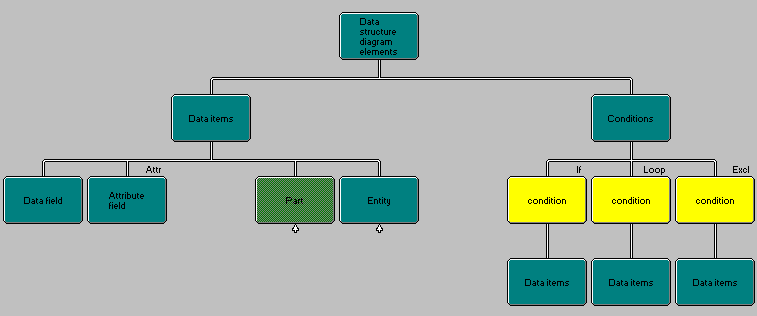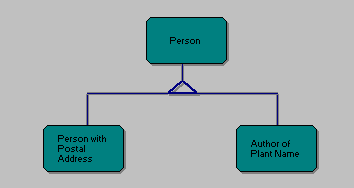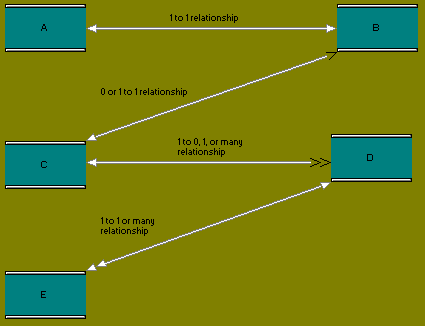
The following definitions and concepts have been intentionally kept simple, for a detailed theoretical approach textbooks about database models and set theory should be consulted. With few exceptions, the definition of terms here given follows Microtool (1995).
Associative Entity see under Entity relation model diagram
Attribute
The header of a column in a relational table (see Entity). A concrete instance assigned to an attribute is called an attribute value.
Cardinality see under Entity relation model diagram
Classification relationship see under Entity relation model diagram
Data element
A class of qualities being used to describe various operational units used by the CASE system to express data. In the present model, a data element must be assigned to every attribute, and one may be assigned to basic (bottom-line) data fields in data structure diagrams. Data elements are unique, but more than one attribute and/or data field may have the same data element assigned to it. The qualities which can be defined are the following:
A data element may represent the specialization of another, in which case it can "inherit" all of the properties of its generalization with the exception of its semantics.
Data integrity rules
Semantic rules for the creation, deletion, or modification of records. These usually have to be enforced by the database management program rather than the database management system.
Data structure diagrams
A hierarchical tree diagram depicting "consists of" relationships between data items if read from top to bottom following the connecting lines. Data items may be data fields, attribute fields, parts, or entities.

The "consists of" relationship may be modified by conditions written in boxes which are marked by an abbreviation on the right hand top of the box defining the kind of condition:
"IF": Data items below this box are to be read only if the condition is satisfied
"EXCL" (= exclusive alternative): Same as "IF", but several such conditions exist which are mutually exclusive
"LOOP", data item is repeated as many times as indicated in the condition.
A diagram may consist of several pages. Small numbers above the first data item point to the higher page, small numbers below point to the page where the respective data item is subdivided in more detail.
A little arrow pointing to the bottom of a shaded (olive-green) data box indicates that the box represents a part, i.e. a separate data structure diagram.
A little arrow pointing to the bottom of an unshaded (green) data box indicates that the box represents an entity, i.e. a set of datafields represented by the attributes in a relation. The name of the entity is given in parenthesis in the box.
"Attr." on the right above a box indicates that the data item directly represents an attribute in a relation.
Entity
A set of objects which can be mapped into a relational table. See relation.
Entities in data structure diagrams are marked by an unshaded (green) box with a little arrow pointing to the bottom of the box.
Entity relation model diagram
The diagram is read along the connecting lines, starting with the entity name, followed by the descriptive text nearest to it, than the cardinality (i.e., how many instances of the second entity are referred to the instance in the first one) and, finally, the name of the second entity.
The cardinality may be "1" (exactly 1), "C" (0 or 1), N (1 to many), or "CN" (0 to many). The "C" is for conditional relationship, i.e. it is possible that no instance is referred to.
Example:

Reads:
A plant name has exactly 1 corresponding name rank. Every name rank is assigned to 0 to many plant names.
In a relational model, N-to-N relationships must be resolved by means of an associative entity in a process called normalization. In the ER model, such associative entities may be expressed by a label attached to the diamond in the connecting line between entities.
Example:

Reads:
A plant name may have 0 to many comments attached to it. A comment may be assigned to 0 to many plant names. In the relational model, the N-to-N relationship is resolved by an entity called Plant Name Comment List, which has at least two attributes (a pointer to Plant Name and a pointer to Comment); i.e. every entry in the Plant Name Comment List corresponds exactly to one assignation of a comment to a plant name.
In some cases it may be appropriate to assign some of the attributes of an entity to a separate entity, because they are used only under specific circumstances. For example, the author of a taxon name is a person, but there are a number of attributes referring only to taxon authors. Such "is-a" relationships may be expressed by super-sub-relationships (Person being the super-entity, Taxon Author the sub-entity). A super-entity is connected to its sub-entities with a line marked by a triangle. Example:

Reads:
Person may be a Person with a postal address and/or an author of a plant name.
This is an inclusive relationship (and/or), represented by the outline of a triangle. If the relationship was to be exclusive, i.e. a person may not be one with a postal address and an author, the triangle would be solid. An equal sign within the triangle indicates that the classification is complete, i.e. only the shown subtypes exist.
ER model see Entity relation model diagram
Foreign key
An attribute in a relation which corresponds to the primary key in another relation. For every assigned value (non null / nil) of the foreign key there must be an equal value in the primary key at all times. The foreign key is assigned to the same data element as the primary key. Foreign keys are the instrument at the logical level to realize relationships between entities in the relational model.
Integrity rules see Data integrity rules and Referential integrity rules
Part
An item in a data structure diagram representing a reference to a subtree depicted in an independent diagram. A part is indicated by a shaded box with a little arrow pointing to its bottom.
Primary key
An unambiguous identifier for every row in a relational table, i.e. an attribute for which all tuples (values) in the table occur only once at any point in time.
Referential integrity rules
Statements to the effect of guaranteeing that a foreign key always corresponds to a primary key. In this model to be applied almost exclusively in the case of deletions of records. Referential integrity is usually enforced by the database management system itself, after relationships have been defined.
Relation
The representation of an entity in the relational model, i.e. a table containing a header consisting of a set of attributes, and a body consisting of a variable set of tuples (rows with values for the attributes). Duplicate rows or attributes are not allowed inside a relation. The relation corresponds to a relational table in the system.
Relational model
Here defined as a network diagram depicting a number of relations together with the relationships connecting them. Derived from an entity relation diagram, the relational model is implementation-oriented, all relationships are normalized and relations may directly represent tables in a database.
Relational model diagrams
Entities are depicted by boxes with a closed pair of lines above and below, arrows depict relationships, text near arrows gives a short characterization of the relationship.
A single closed arrowhead is a "1 to " relationship, a single open arrowhead is a "0 or 1 to " relationship. Respectively, open double arrows mean "0 - n to", closed arrows "1 - n to" relationships.
Example:

Reads:
An entry (tuple) in table (entity) A is related to exactly 1 entry in table B.
An entry in table B is related to exactly one record in table A and exactly one record in table C.
An entry in table C may be related to no entry or to one in table B; and to no entry, one or many in table D.
An entry in table D must be related to exactly one entry in table C; and to one or more entries in table E.
Finally, every single entry in table E must be related to exactly one record in table D.
Relational table see Relation
Relationship
A connection between entities which allows to form sets containing values of attributes from both entities.
Next chapter; Contents of this article; Complete entity list; References cited; Author information. Last updated: June 23, 1995